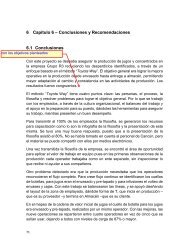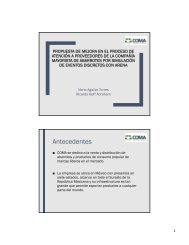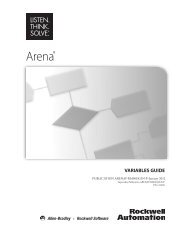Getting Started
You also want an ePaper? Increase the reach of your titles
YUMPU automatically turns print PDFs into web optimized ePapers that Google loves.
4 • THE ADVANCED PROCESS PANEL<br />
Prompt<br />
Resource Name<br />
Set Name<br />
Attribute Name<br />
Expression<br />
Quantity<br />
Selection Rule<br />
Save Attribute<br />
Set Index<br />
Resource State<br />
Queue Type<br />
Queue Name<br />
Description<br />
Name of the resource that will be seized.<br />
Name of the resource set from which a member will be seized.<br />
Name of the attribute that stores the resource name to be seized.<br />
Expression that evaluates to a resource name to be seized.<br />
Number of resources of a given name or from a given set that<br />
will be seized. For sets, this value specifies only the number of a<br />
selected resource that will be seized (based on the resource’s<br />
capacity), not the number of members to be seized within the set.<br />
Method of selecting among available resources in a set. Cyclical<br />
will cycle through available members (for example, 1-2-3-1-2-<br />
3). Random will randomly select a member. Preferred Order<br />
will always select the first available member (for example, 1, if<br />
available; then 2, if available; then 3). Specific Member requires<br />
an input attribute value to specify which member of the set<br />
(previously saved in the Save Attribute field). Largest<br />
Remaining Capacity and Smallest Number Busy are used for<br />
resources with multiple capacity.<br />
Attribute name used to store the index number into the set of the<br />
member that is chosen. This attribute can later be referenced with<br />
the Specific Member selection rule.<br />
Index value into the set that identifies the number into the set of<br />
the member requested. If an attribute name is used, the entity<br />
must have a value for the attribute before utilizing this option.<br />
State of the resource that will be assigned after the resource is<br />
seized. The resource state must be defined with the Resource<br />
module.<br />
Determines the type of queue used to hold the entities while<br />
waiting to seize the resource(s). If Queue is selected, the queue<br />
name is specified. If Set is selected, the queue set and member in<br />
the set are specified. If Internal is selected, an internal queue is<br />
used to hold all waiting entities. Attribute and Expression are<br />
additional methods for defining the queue to be used.<br />
This field is visible only if Queue Type is Queue, and it defines<br />
the symbol name of the queue.<br />
63






